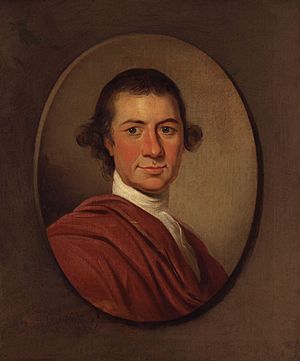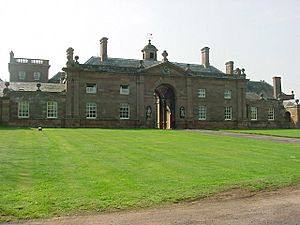George Pigot, 1st Baron Pigot facts for kids
Quick facts for kids
George Pigot
|
|
|---|---|
 |
|
| President of the British East India Company | |
| In office 14 January 1755 – 14 November 1763 |
|
| Preceded by | Thomas Saunders |
| Succeeded by | Robert Palk |
| In office 11 December 1775 – 23 August 1776 |
|
| Preceded by | Alexander Wynch |
| Succeeded by | George Stratton |
| Personal details | |
| Died | 11 May 1777 |
George Pigot (born 4 March 1719 – died 11 May 1777) was an important British official. He served twice as the leader, or President, of the British East India Company in Madras, India. This company was a powerful trading group that also governed large parts of India for Britain.
Contents
Early Life and Family
George Pigot was the oldest son of Richard Pigot. His mother was Frances, whose family had come to England from France. George had two younger brothers who also became famous. One brother, Hugh Pigot, became an Admiral in the Royal Navy. His other brother, Robert, became a military officer.
Working for the East India Company
George Pigot started working for the East India Company in 1736 when he was just 17 years old. He worked his way up and, after 19 years, became the Governor and Commander-in-Chief of Madras in 1755. This meant he was in charge of the city and its defenses.
While in charge, he successfully defended Madras when the French army attacked it in 1758-1759. He also helped the company take control of Pondichéry. In 1761, after Pondichéry was captured, George Pigot insisted that it should belong to the East India Company, not the British Crown. He even threatened to stop providing money for the King's soldiers if his demands were not met. Eventually, he got his way and had the city's defenses destroyed.
He left his position in India in November 1763 and went back to Britain. For his service, he was given the title of Baronet in 1764. This is a special honor from the King.
Life in Britain
After returning to Britain, George Pigot bought a large estate called Patshull Hall in 1765. He also became a member of the British Parliament, representing the area of Wallingford from 1765 to 1768. In 1766, he received another special title, Baron Pigot, which made him a peer in Ireland. From 1768 until his death, he represented Bridgnorth in Parliament.
Return to India and Challenges
In 1775, George Pigot went back to India to be the Governor of Madras again. However, he soon faced big problems. He got into a serious disagreement with most of the other leaders on his council. This fight was about whether to give back power to the local ruler, the Rajah of Tanjore.
The disagreement became so intense that George Pigot was arrested by his opponents. He was still held as a prisoner when he died on 11 May 1777.
Back in Britain, the leaders of the East India Company had decided that George Pigot's actions were wrong. They ordered that he be removed from his position, but this news arrived after he had already passed away.
Later, in 1779, the British Parliament discussed what had happened to George Pigot. Four of the people who were responsible for his arrest were put on trial. They were found guilty and each had to pay a fine of £1,000.
The Pigot Diamond
George Pigot owned a very famous diamond, which is now known as the Pigot Diamond. When he died, he left it to his family. Eventually, the diamond left the family through a lottery. No one knows where the Pigot Diamond is today.
Images for kids
-
Pondicherry after the Siege of Pondicherry, showing the destroyed fort.



